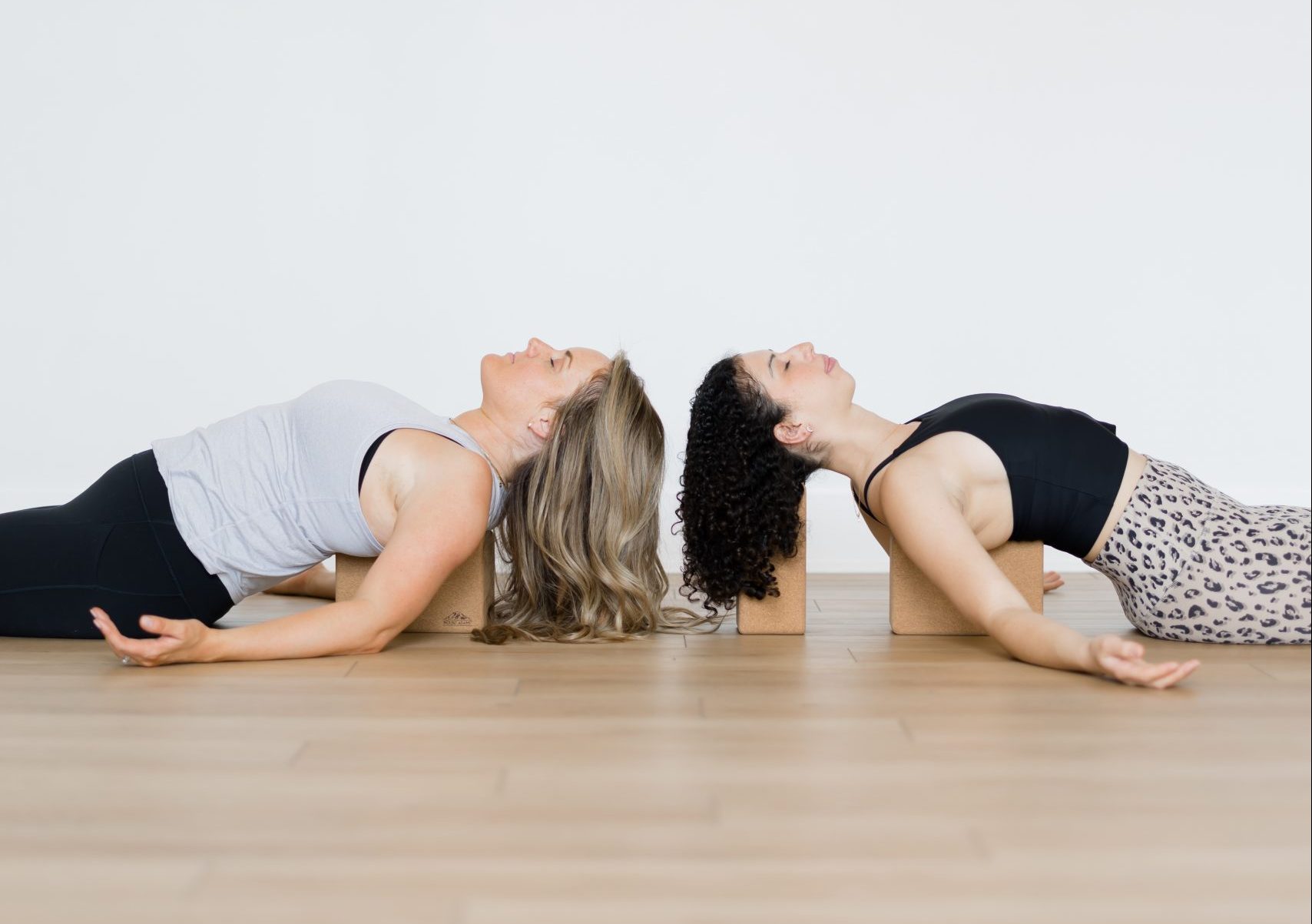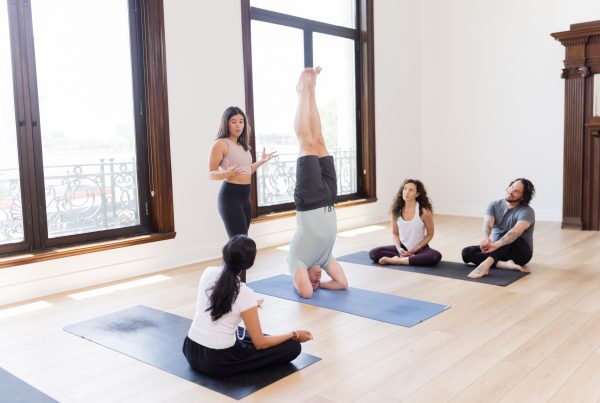
It was 2019. And on Sunday afternoons, as the weekend would come to a close, I would head to my yoga studio for the 4:30PM yin yoga class. It was 75-minutes long and I’d make sure to get there extra early so I could savor some additional quiet time on my mat.
I’d walk in and inhale the smell of nag champa incense that would immediately set my mind into relaxation mode. My ears would welcome the soft music playing in the background of the studio, which was often lit by candlelight. When class would begin I would settle into this time on my mat and drop deeply into relaxation, breathing through each pose as I released physical tension in my body and cloudiness in my mind.
My weekend would end and I’d head into the week ahead with a sense of clarity and calm.
And then… 2020 came. ?
The pandemic arrived.
The studio closed.
I became a mom.
And gone were the slow Sunday afternoons spent focused on 2-hours of yin yoga.
That little routine is something I look back fondly on and definitely miss. But, as time has moved forward I’ve learned to accept that it’s just not part of my reality in this season of life.
I’ve had to get much more efficient at finding ways to practice and reduce stress when I’m often doing a class in my bedroom while my toddler naps in the room next door.
And for me, that usually looks like a 30-minute yin yoga class focused on stress relief that I can fit in anytime and anywhere during the day (or night… any bedtime warriors out there with me?!).
This full-body yin yoga sequence has become a go-to of mine because it leaves me feeling open, relaxed, and gives me that same feeling of clarity that my Sunday ritual used to leave me with.
Grab some props if you have them– I recommend two blocks, one blanket, and a bolster as a basic setup– turn on some music and light a candle. It may not be 2-hours long, but this practice will still be oh-so-sweet.
30-Minute Yin Yoga Sequence to Release Stress
Starting Meditation in Virasana (3 minutes)
Why it’s great:
Starting practice with a few minutes of focused breathing helps to pull the mind into the present moment and lay the foundation for practice. Virasana (with blocks) is a personal favorite because it allows for the spine to really lengthen so there’s space to focus on the fullness of each breath.
How to do it:
- Bring a block (or two) on the short height long ways between your ankles.
- Stand up on your shins and then sit back on your blocks.
- Gently lift the low belly in to support the lengthening of the spine.
Insider tip: Feel free to light that incense or use some essential oils beforehand so you still get those yoga studio vibes at home.
Heart Bench (4 minutes)
Why it’s great:
Opening the heart space right at the start of practice helps to melt away the physical tension we often carry in the upper back and shoulders throughout the day. This pose also allows the breath to move freely through the abdomen which allows for increased oxygenation of the blood which refreshes the mind. Plus, the tall block helps to gently tuck the chin ever-so-slightly towards the chest which signals the brain to move towards relaxation.
How to do it:
- Place one block on the medium height longways facing the top of your mat and the other block on the tall height about 4 inches behind it.
- Lay back on the blocks so the bottom block sits right between your shoulder blades with the bottom edge of the block meeting the bottom edge of the shoulders. The top block comes under your head at the base of the skull so your chin tilts slightly towards your chest.
- Extend your legs out long.
Insider tip: If this bothers your low back bend your knees and take your feet as wide as your mat. Let your knees knock in towards center so the weight of your legs support each other.
Square Pose (right leg on top) (5 minutes)
Why it’s great:
Stress can often lead to built up tightness in the hips and this pose gets right to stretching and releasing the tension that gets stored in this area of the body. While it can be intense, this pose is super effective at creating the connection to breath to create a sense of ease for the body and the mind. Plus, the forward fold element of the pose helps to shift out of the sympathetic nervous system– fight for flight– and towards the parasympathetic nervous system– rest and restore.
How to do it:
- Start with both feet out in front of you and your knees bent.
- Cross your right ankle over your left knee to create a figure four shape.
- Slide your left foot across your mat to the right side so your shins stack and your ankles and knees are lined up. Space between your top knee and bottom ankle is totally fine, but if your bottom knee doesn’t reach the floor, slide a blanket underneath to protect it.
Insider tip: If the stacking of the shins feels like way too much today, you can stay in the figure four shape and breathe here. This will still open up the hip and target the same areas of the body.
Dragonfly Pose (5 minutes)
Why it’s great:
While the hamstrings and backs of the legs often get the most attention here, this pose actually opens up the whole back body, which helps to provide relief even in those hard-to-reach areas of the neck, shoulders, and lower back. Forward folds are calming for the nervous system and helps the mind drop into deep relaxation.
How to do it:
- Turn to face the long side of your mat.
- Open your legs out wide and then relax muscle engagement in the legs.
- Fold your upper body forward from the hips and relax your head down.
- Allow your body to move with gravity and release further and further into the pose.
Insider tip: I personally love this pose with some type of prop support under my head– usually a block with a blanket on top. The gentle pressure of the prop right at the third-eye point helps to create extra grounding and relieve stress.
Square Pose (left leg on top) (5 minutes)
Why it’s great:
See above! It’s still great on the left side for the same reasons. 🙂
How to do it:
- Start with both feet out in front of you and your knees bent.
- This time, cross your left ankle over your right knee to create the figure four shape.
- Slide your right foot across your mat to the left side so your shins stack and your ankles and knees are lined up. Space between your top knee and bottom ankle is totally fine, but if your bottom knee doesn’t reach the floor, slide a blanket underneath to protect it.
Insider tip: It’s totally ok if this side feels really different from the other side. Sometimes on one side the shins stack and on the other you need to stay in the figure-four shape. Yin yoga is all about honoring your body where is is today– so give yourself permission to do what feels right.
Reclined Butterfly Pose with Heart Opener (3 minutes)
Why it’s great:
Practicing this yin posture at the end of the sequence is a nice way to squeeze in a few final minutes of openness before moving into savasana. This shape opens the chest, pelvis, inner things, and hips all at once– which feels like a giant exhale for the entire body. Plus, it’s very easy to focus on your breathing in this position.
How to do it:
- Lay a bolster long ways on your mat with a blanket towards the top of the bolster as a pillow for your head.
- Sit with your feet on the floor in front of you, knees bent, and low back right at the bottom edge of the bolster and lay back so your upper body is fully supported by the bolster.
- Bring the soles of your feet to touch and open your knees out wide to the sides. Your hands can rest gently beside you, or you can even place on on your heart and one on your belly and breathe into your hands.
Insider tip: If this feels like too deep of a backbend, you can use blocks in the same heart bench setup from the first pose and place the bolster over the blocks. This will still create all of the chest opening, but with less intensity in the low back.
Savasana (5 minutes)
Why it’s great:
All great things must come to an end– including your yoga practice for the day. But, the sweet relief of savasana makes it so much easier to bring your practice to a close. This pose is the opportunity for all of your efforts and work to take root into the systems of your body– both physically and energetically. While you rest and breathe in savasana all of the good things from your practice are cemented into place so you can carry them with you from that point forward.
How to do it:
- Set all of your props aside and come to lay back down on your mat.
- Let your body be fully release into the support beneath you.
- Close your eyes and allow yourself to relax into your breath.
Insider tip: While you don’t need any to do this pose, props can make savasana feel extra relaxing. Feel free to grab your bolster and place it under your knees or your blanket under your head. Take whatever setup feels most comfortable for you.
Want my full run-down on how to get started teaching yin yoga classes? Grab my totally free Yin Yoga Teacher Starter Kit, which will give you everything you need to know to teach your first yin yoga class.






